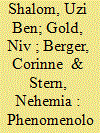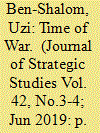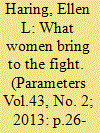| Srl | Item |
| 1 |
ID:
141785


|
|
|
|
|
| Summary/Abstract |
The formal model of modern-system force employment developed in Stephen Biddle (2004) book, Military Power, is a standard text in the defense analysis field but has rarely been applied to analyze battlefield outcomes. The 2008 Five-Day War between Russia and the Republic of Georgia provides a compelling case study for empirical testing. The outcome of the conflict reveals an inconsistency between the theoretical model and the actual results, suggesting that technical and tactical force employment variables alone may not be sufficient to explain battlefield dynamics, and that the effects of psychological shock on unit morale and cohesion may constrain how well a military force can perform even while adhering to modern-system doctrine.
|
|
|
|
|
|
|
|
|
|
|
|
|
|
|
|
| 2 |
ID:
180042


|
|
|
|
|
| Summary/Abstract |
This article analyses the experiences of IDF soldiers involved in subterranean operations in Gaza. While tunnel warfare is a central element in warfare, few sociological studies have focused on this element of combat. In-depth interviews reveal the day-to-day experiences of the specialised combat engineering units tasked with subterranean operations during the past two decades. The themes identified are: ‘Operational activity in tunnels as an experience’, ‘Courage and danger’, ‘Selection and classification of manpower’ and ‘Accumulating experience’. An awareness for generational differences in the narratives allows an analytical model based on four different models for organising forces for operations in tunnels.
|
|
|
|
|
|
|
|
|
|
|
|
|
|
|
|
| 3 |
ID:
164291


|
|
|
|
|
| Summary/Abstract |
This paper explores the construction of combat motivation in the Israel Defense Forces (IDF), arguing that although Israeli society at large is in a ‘Post Heroic’ era, the ‘Heroic Spirit’ is revealed during emergencies. A total of 1535 questionnaires were administered among combat soldiers during large-scale operations fought during national emergency and during small-scale routine operations. The results reveal differences in the construction of combat motivation typical for emergency vs. routine, as well as for reserves vs. regular units. These results indicate that the Post Heroic era is a condition that could be shifted according to cultural, organisational and individual determinants. This paper discusses the roots of these constructions and their implications on the theory of combat motivation and combat experience.
|
|
|
|
|
|
|
|
|
|
|
|
|
|
|
|
| 4 |
ID:
185253


|
|
|
|
|
| Summary/Abstract |
This study presents an empirically grounded account of tunnel combat operations in the Israel Defense Forces (IDF) within the context of “post-heroic” warfare. Current scholarship on “post-heroism” has viewed the technological and professional standards of contemporary military conflicts as distancing the individual combatant from the modern battlefield. Little attention has been given however to the ways in which soldiers themselves experience and adapt to post-heroic conditions. Findings based on in-depth semistructured interviews with 17 IDF tunnel combatants show these soldiers actively reinterpreting the strategic importance placed on distancing the warrior from the battlefield. This exploratory article suggests that an individual “warrior ethos” still resonates amid the professional and technological contours of post-heroic (underground) conflicts. By presenting a novel account of contemporary tunnel warfare from the perspective of the combatants themselves, this research sheds new light on the different personal dimensions that impact post-heroic military operations.
|
|
|
|
|
|
|
|
|
|
|
|
|
|
|
|
| 5 |
ID:
124232


|
|
|
|
|
| Publication |
2013.
|
| Summary/Abstract |
The recent decision to integrate the US military fully was met with a range of emotions. For some it was a misguided decision that would erode combat effectiveness and have negative consequences for US security. Various objections were raised to justify keeping women out of combat units but most have been demolished by ten years of combat. This article exposes the flaws in two of the more persistent objections: (1) the presence of women in combat units will erode the vital bond that develops between men and (2) women are not as strong as men and so put male soldiers at risk.
|
|
|
|
|
|
|
|
|
|
|
|
|
|
|
|
| 6 |
ID:
167460


|
|
|
|
|
| Summary/Abstract |
The current combat motivation model based on primary group thesis assumes that the main force behind motivation is peer-bonding or otherwise known as unit cohesion. Cohesion is perceived as an all-encompassing factor that leads to satisfactory (or unsatisfactory in lack thereof) military effectiveness and performance in conflict environments. However, the article identifies three main problems with this perspective: 1. mono-dimensional view of motivation; 2. motivation based on heteronomy, and 3. self-reporting bias. The current model does not consider motivation as a separate entity from cohesion; it does not place motivation as fundamental human value; lastly, it takes motivation as granted by-product of socialization. The article proposes a new combat motivation model based on The Self-Determination Theory. The theory maintains that human motivation requires satisfaction of three psychological needs of competence, relatedness, and autonomy. The degree of satisfaction of those three needs leads to different types of regulated motivations – a continuum from intrinsic to extrinsic – each of which has specifiable consequences for learning, performance, and well-being of an individual.
|
|
|
|
|
|
|
|
|
|
|
|
|
|
|
|